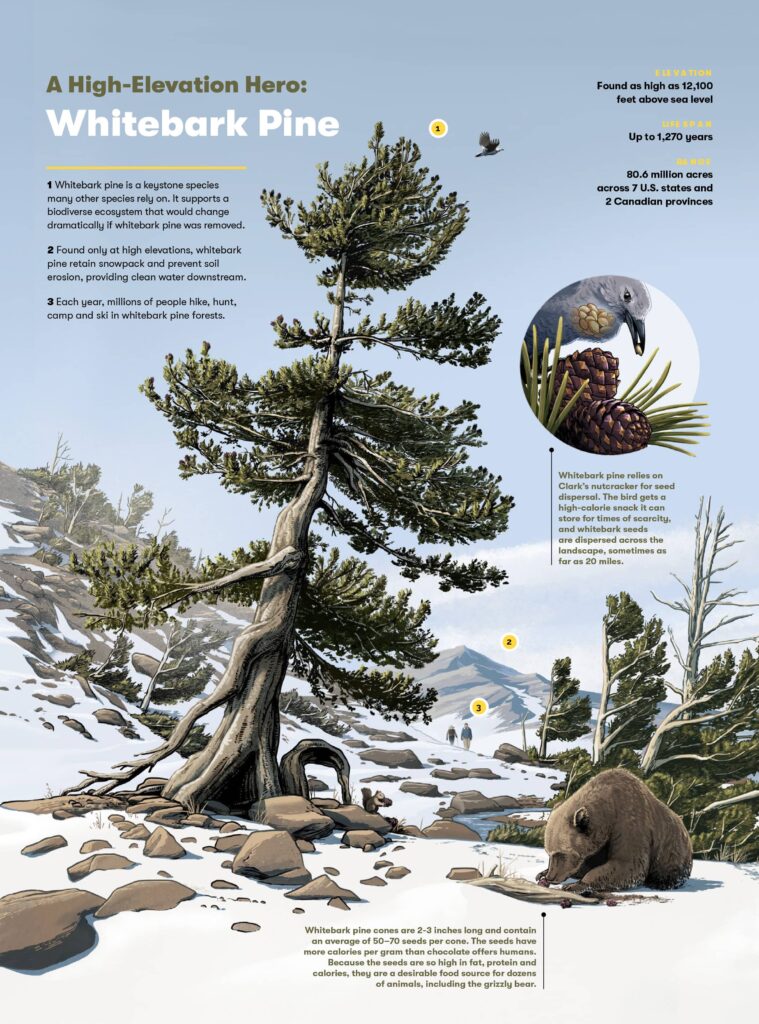Whitebark pine defines many of America’s most treasured Western landscapes. Their forests grow across seven U.S. states, including national parks and forests. Every year, people hike, camp, ski, fish and hunt among whitebark pine.
Found in the high elevations of soaring mountains, these marvelous trees can endure thin, rocky soil and extreme weather. They are the center of life for many high-elevation ecosystems, supplying nutritious seeds to species like Clark’s nutcrackers and grizzly bears and other animals. Whitebark pine forests are also vital to the health of our drinking water.
But this tree is in danger.
Right now, whitebark pine is facing a trio of threats: a deadly disease, a pest and climate change. White pine blister rust, an invasive fungus that slowly kills the tree, is the greatest threat. It is estimated more than 325 million whitebark pine trees have been wiped out. In 2022, whitebark pine was listed as threatened under the Endangered Species Act. If not restored, whitebark pine forests will be permanently altered, impacting their ability to provide important environmental and societal benefits.
This is a solvable crisis
We’ve made incredible progress in saving this iconic tree: in 2023, American Forests and the National Park Service signed an agreement to restore whitebark pine in national parks across its range.
American Forests is also partnering with governments and dedicated organizations, like the Whitebark Pine Ecosystem Foundation, to protect and restore whitebark pine across its range, using the best available science. By planting diverse, disease-resistant seedlings and managing living trees, land managers have an opportunity to regenerate whitebark pine forests.
How we will bring whitebark pine back
- Planting disease-resistant seedlings. Certain trees have genetic resistance to white pine blister rust. By identifying these parent trees and planting seedlings grown from their seeds, researchers and land managers can grow forests able to withstand blister rust.
- Managing threats to living trees. Living trees can be protected from mountain pine beetle using pheromones and other treatments. Surrounding forests can be managed to limit excess fuel, reducing the likelihood of high-severity fires.
- Funding restoration activities. Funds help pay for activities critical to whitebark pine restoration, including research, seed collection, genetic testing, seedling cultivation in greenhouses, planting and monitoring.
- Growing the number of trained specialists. An expanded workforce of trained specialists is needed to collect more seeds, and grow and plant more disease-resistant seedlings.
- Developing and implementing a restoration plan. American Forests is collaborating with researchers and federal, state and Tribal land managers to develop the National Whitebark Pine Restoration Plan, a science-informed guide to restore whitebark pine.
To support restoration, American Forests is raising awareness about whitebark pine and coordinating with partners to expand the capacity needed to scale up reforestation efforts.
Join the movement to Save the Whitebark Pine
Sign up to receive email updates on whitebark pine and join a coalition of advocates.
Email addresses may be shared with Save the Whitebark Pine campaign partners.
Share your support for whitebark pine. Help spread the word about this important tree, the threats it faces and the hope for restoration with your friends and colleagues on social media.
“Hope and Restoration – Saving the Whitebark Pine” is a powerful documentary short that tells the story of whitebark pine and the people and organizations working to restore this threatened species. You can bring this film to your community and help raise awareness about the need to Save the Whitebark Pine. Check out our screenings toolkit for guidance on how to host your own watch party.










